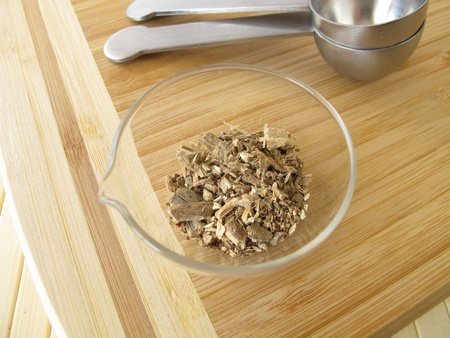Condurango - Marsdenia condurango

Common Names: Condurango, Marsdenia, Condor plant, Eagle vine, Common condorvine, Bejuco de Condor, Bejuco de Sapo, Condurango blanco, Mata-peroo, Tucacsillu, Condurango (international, Spanish origin), Marsdenia condurango (Latin scientific name)
Latin Name: Marsdenia condurango
Origin: South America
Short Introduction
Condurango cannot be cultivated in the Czech Republic due to unsuitable conditions. This plant prefers a tropical environment and grows at elevations higher than those found in Central Europe.
Detailed Description
Condurango is a traditional herb used for digestive discomfort.
Botanical Information
Condurango is a climbing and twining shrub, with stems reaching up to 10 meters in length. The plant is woody, quite sturdy, and can spread up to 0.75 meters wide. Its leaves are small, opposite, petiolate, oval-shaped, and have a greenish-yellow hue. The leaf edges are silky smooth and entire, with regular panicle inflorescences in the leaf axils. The flowers are funnel-shaped and brownish-green. The fruit is a long follicle filled with numerous seeds covered in fine down.
Origin and Distribution
Condurango originates from regions of South America, specifically present-day Peru, Colombia, and Ecuador. Marsdenia prefers mountainous areas and is commonly found in nature in jungle and cloud forest habitats at altitudes of 2,000 to 3,000 meters above sea level.
Usage / Dosage
For many years, Condurango has been used by local populations to treat various digestive ailments and stomach problems. It was often employed for the management of ulcers, and to support liver and pancreas health. Condurango was first introduced to the Western world in 1871, when the president of Ecuador presented it to the then president of the United States, accompanied by a physician's certification that Condurango was an excellent remedy against stomach cancer and syphilis.
Traditional folk medicine applications focus heavily on the gastrointestinal tract. Folk healers recommend wine made from Condurango bark to calm the stomach, reduce dizziness, and ease nausea. It is known to stimulate appetite, alleviate anorexia, improve digestion, boost bile production, relieve stomach pain, and help with bloating. Healers have also used Condurango for gastric or other gastrointestinal bleeding, as well as for the prevention of gastric ulcers. Due to its astringent properties, Condurango is traditionally recommended for treating diarrhea caused by spoiled or tainted food.
In Peru, Condurango is respected in folk medicine as an analgesic (pain reliever), appetite stimulant, carminative (gas expelling), cholagogue (stimulating bile flow), hemostatic (preventing bleeding), stomachic (digestive aid), and tonic.
It has also been traditionally used for snake bites. In Brazil, Condurango is used to stimulate appetite, alleviate gastritis, dyspepsia, headaches, stomach aches, and rheumatism. Similar therapeutic applications are found across Colombia, Ecuador, other Latin American countries, and even in Germany, the UK, and the USA.
In the United States, Condurango is further popularized as an analgesic, antiseptic, cytostatic (cell growth inhibiting), and for conditions such as anorexia, beriberi, gastritis, rheumatism, snake bite, ulcers, and syphilis.
Condurango’s active compounds have been studied in animal models and shown anti-inflammatory and antioxidant effects, especially in fighting common fungal infections and mycobacteria, responsible for tuberculosis, with positive results. However, the results against viral pathogens were not promising.
Active Compounds
Marsdenia condurango contains a significant compound called conduritol, or cyclitol, a cyclic polyalcohol with notable therapeutic effects in the human body. Conduritol was first extracted by pharmacist Kubler in 1908 from the bark of Condurango. Other important substances found in Condurango include glycosides and steroids.
In the hundred years since its discovery, Condurango has become widely known in the West, with many studies—particularly in Japan and the USA—examining its compounds and their anti-cancer properties. The concentration of glycosides in the bark of Marsdenia is typically about 1-3%. Other components include hydroxylated pregnane derivatives, caffeine, cyclitols, flavonoids, and coumarin derivatives.
Traditional Dosage
There are many commercial products containing Condurango, but they should always include Condurango bark extract. For those using dried bark to prepare tea, it is recommended to decoct 5–10 g of dried bark and drink one cup of the decoction 2–3 times daily. To prepare, place 1 teaspoon of bark in cold water (approximately 250 ml), bring to a boil, and simmer for 10 minutes. Let it stand, stir before straining, and drink lukewarm, as the active compounds precipitate in hot water.
For capsules, a typical dose is about two 1-gram capsules twice daily. For pure extract, use 3 ml twice daily. Condurango wine is generally consumed at a dose of 50 ml 3–4 times per day, not exceeding 200 ml per day.
